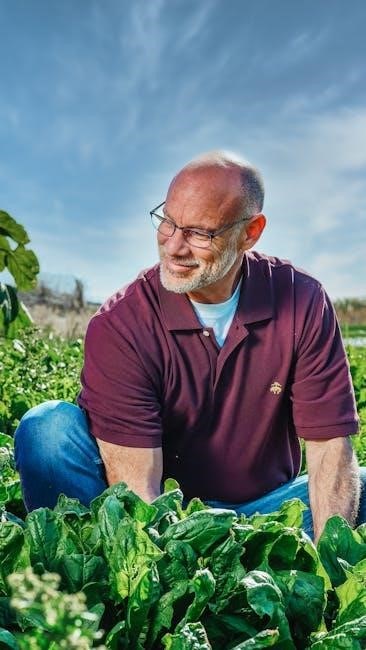Welcome to the EarthBox Growing Guide! This innovative‚ self-watering system simplifies gardening‚ making it easy to grow fresh produce in small spaces. Perfect for all skill levels‚ it ensures maximum yields with minimal effort.
What is an EarthBox?
An EarthBox is a revolutionary‚ self-contained gardening system designed for growing plants in a variety of settings. It is a self-watering container that uses a unique design to optimize water and nutrient delivery to plants. The system includes a growing medium‚ fertilizer‚ and a built-in water reservoir‚ making it ideal for small spaces‚ balconies‚ or backyard gardens. Its innovative aeration screen and water fill tube ensure proper drainage and moisture retention‚ preventing root rot and overwatering. The EarthBox is perfect for gardeners of all skill levels‚ providing a low-maintenance way to grow fruits‚ vegetables‚ and herbs. Its compact design and efficiency make it a popular choice for urban gardening and seasonal crop production. By simplifying the gardening process‚ the EarthBox empowers anyone to grow fresh‚ healthy produce with minimal effort and expertise.
Benefits of Using an EarthBox
The EarthBox offers numerous advantages for gardeners‚ making it a versatile and efficient gardening solution. Its self-watering design ensures consistent moisture levels‚ reducing the need for frequent watering and minimizing the risk of overwatering. This makes it ideal for busy individuals or those new to gardening. The system is space-efficient‚ perfect for small balconies‚ patios‚ or backyard gardens‚ allowing you to maximize your growing area. It also promotes healthy plant growth by delivering nutrients directly to the roots‚ leading to higher yields and better fruit quality. The EarthBox is durable and reusable‚ providing long-term value for gardeners. Additionally‚ it simplifies the gardening process by eliminating the guesswork of watering schedules and nutrient delivery. Overall‚ the EarthBox is a practical and effective way to grow fresh‚ healthy produce with minimal effort and expertise.

Setting Up Your EarthBox
Setting up your EarthBox is simple and straightforward! Gather your container‚ aeration screen‚ water fill tube‚ and potting medium. Assemble the components‚ add fertilizer‚ and fill with soil. It’s ready to plant in minutes!
Materials Needed for Assembly
To assemble your EarthBox‚ you’ll need a few essential components. Start with the EarthBox container‚ which includes the aeration screen and water fill tube. Next‚ gather 2 cubic feet of high-quality potting medium. Add one bag of dolomite‚ a special blend that prevents nutrient deficiencies and promotes healthy plant growth. You’ll also need a bag of starter fertilizer and a high-analysis fertilizer for optimal plant nutrition. Don’t forget the plastic mulch cover to retain moisture and regulate soil temperature. Finally‚ ensure you have seeds or seedlings ready for planting. These materials work together to create a self-sustaining growing system that maximizes yields and minimizes effort. Proper assembly ensures your plants receive the right amount of water‚ nutrients‚ and oxygen for thriving growth. With these items on hand‚ you’re ready to set up your EarthBox and begin your gardening journey!

Step-by-Step Assembly and Initial Setup
Assembling your EarthBox is a straightforward process that ensures optimal growing conditions. Start by inserting the water fill tube into the round opening on the container. Next‚ place the aeration screen at the bottom to improve air circulation. Fill the box with 2 cubic feet of high-quality potting medium‚ spreading it evenly. Cut a slit in the plastic mulch cover and place it over the soil to retain moisture and regulate temperature. Add the dolomite and starter fertilizer as directed‚ mixing gently into the top layer of the growing media. Finally‚ plant your seeds or seedlings according to the recommended spacing and cover with a thin layer of potting mix. Water thoroughly through the fill tube until the water reservoir is full. This setup ensures efficient watering and nutrient delivery‚ promoting healthy root growth and robust plant development. Once complete‚ your EarthBox is ready for a successful growing season!

The EarthBox Planting Guide
The EarthBox Planting Guide offers expert advice for selecting and planting a wide variety of fruits‚ vegetables‚ and herbs. Follow specific guidelines for spacing‚ fertilization‚ and growing media to ensure a bountiful harvest.
Choosing the Right Plants for Your EarthBox
Selecting the right plants for your EarthBox is crucial for a successful harvest. The EarthBox system supports a wide variety of plants‚ including vegetables‚ fruits‚ and herbs‚ making it versatile for diverse gardening goals. Consider plants that thrive in container environments‚ such as tomatoes‚ peppers‚ cucumbers‚ and leafy greens like lettuce and spinach. Herbs like basil‚ mint‚ and parsley also grow exceptionally well in EarthBoxes. When choosing plants‚ ensure they have similar sunlight‚ water‚ and temperature requirements to optimize growth. Larger plants like tomatoes may need more space‚ while smaller plants can be grouped together for efficient use of the box. Refer to the EarthBox planting charts for specific recommendations on spacing‚ light exposure‚ and fertilizer placement. This ensures your plants receive the right conditions to flourish. By selecting compatible plants‚ you can maximize yields and enjoy a bountiful harvest from your EarthBox garden.
Plant Spacing and Arrangement
Proper plant spacing and arrangement are essential for maximizing growth and yield in your EarthBox. Overcrowding can lead to reduced airflow‚ increased risk of disease‚ and competition for nutrients. Refer to the EarthBox planting charts for specific spacing recommendations‚ as different plants have varying space requirements. Larger plants‚ such as tomatoes or eggplants‚ should be placed toward the back or sides of the box to allow ample room for growth. Smaller plants‚ like lettuce or herbs‚ can be grouped together in the remaining space for efficient use of the container. Ensure that tall plants do not shade smaller ones by arranging them strategically. Proper spacing also promotes healthy root development and even light distribution. For seedlings or transplants‚ plant them at the same depth as they were in their pots and water gently to settle the soil. Avoid overcrowding to give each plant enough room to thrive‚ ensuring a productive and healthy harvest from your EarthBox garden.
Fertilization Tips and Recommendations
Fertilization is a critical step in ensuring robust growth and abundant harvests in your EarthBox. Start by incorporating the EarthBox Starter Fertilizer Blend‚ which contains dolomite and essential nutrients‚ into the growing media during setup. This helps prevent nutrient deficiencies and promotes healthy root development. Additionally‚ apply the EarthBox High-Analysis Fertilizer according to package instructions‚ typically every 7-10 days‚ to provide a steady supply of nutrients. For optimal results‚ mix the starter fertilizer into the top 3-4 inches of the growing media before planting. Avoid substituting dolomite with hydrated lime‚ as it can disrupt soil pH balance. Regularly top-dress with a balanced fertilizer to maintain soil fertility. Over-fertilizing can harm plants‚ so adhere to recommended dosage guidelines. Proper fertilization ensures your plants receive the necessary nutrients for thriving growth and maximum yield in your EarthBox garden.
Mixing the Growing Media
Creating the right growing media is essential for optimal plant growth in your EarthBox. Start with 2 cubic feet of high-quality potting soil‚ ensuring it is lightweight and drains well. Avoid using garden soil‚ as it can compact and restrict root growth. Add the EarthBox Dolomite/Starter Fertilizer Blend according to the instructions‚ mixing it into the top 3-4 inches of the growing media. This step is crucial for maintaining proper soil pH and providing essential nutrients. Next‚ incorporate the EarthBox High-Analysis Fertilizer strip into the soil‚ placing it in the center of the box for even nutrient distribution. Gently mix the soil to ensure uniformity‚ taking care not to damage the aeration screen or water reservoir. Fill the box to the top‚ leaving enough space for the water reservoir to function properly. Properly mixed growing media ensures healthy root development‚ proper drainage‚ and consistent nutrient availability‚ setting your plants up for success from the start.

EarthBox Maintenance Tips
Regular watering‚ mulching‚ and fertilizing are key to maintaining your EarthBox. Check soil moisture daily‚ apply mulch to retain water‚ and fertilize every 1-2 weeks for optimal plant health and productivity.
Watering Your EarthBox
Proper watering is essential for optimal growth in your EarthBox. The self-watering system relies on a built-in water reservoir that delivers moisture to the roots as needed‚ reducing the risk of overwatering. Water your EarthBox when the soil feels dry to the touch‚ typically every 1-3 days depending on weather conditions. Avoid letting the water reservoir completely empty‚ as this can stress the plants. For seedlings or newly transplanted plants‚ water gently but thoroughly to settle the soil. Mulching can help retain moisture and reduce evaporation. Overwatering can lead to root rot‚ so ensure the water level does not exceed the fill tube. During hot or windy weather‚ check the reservoir more frequently to maintain consistent moisture levels. Regular fertilization and proper drainage will also support healthy root development and water absorption.
Mulching and Moisture Retention

Mulching is a key practice for maintaining optimal moisture levels in your EarthBox. By covering the soil surface with a thin layer of mulch‚ you can significantly reduce water evaporation and retain essential moisture. Organic mulch like straw‚ bark chips‚ or grass clippings works well‚ while the EarthBox system also provides a plastic mulch cover for added efficiency. Proper mulching ensures that the growing media stays consistently moist but not waterlogged‚ promoting healthy root development. Apply a 1-2 inch layer of mulch around plants‚ keeping it a few inches away from the base to prevent overcrowding. During hot or windy weather‚ mulching becomes even more critical to maintain soil moisture. Regularly check the mulch layer and replenish as needed to ensure it remains effective. This simple step not only conserves water but also regulates soil temperature‚ creating a more stable environment for your plants to thrive.

Troubleshooting Common Issues
Identify and address common challenges like pests‚ nutrient deficiencies‚ or overwatering. Regular monitoring and proactive solutions ensure healthy plant growth. Refer to specific guides for detailed solutions and prevention tips.
Managing Pests and Diseases
To ensure a healthy harvest‚ monitor your EarthBox regularly for signs of pests or diseases. Common issues include aphids‚ whiteflies‚ spider mites‚ and fungal infections like powdery mildew or root rot. Inspect plants thoroughly‚ especially the underside of leaves‚ where pests often hide.
For pest control‚ introduce natural predators like ladybugs or lacewings‚ or use neem oil and insecticidal soap as eco-friendly solutions. Avoid harsh chemicals to protect beneficial insects. For diseases‚ remove infected areas promptly and treat with fungicides if necessary. Improve air circulation by properly spacing plants and ensuring good drainage to prevent moisture-related issues.
Preventative measures include using disease-free seeds‚ sterilizing tools‚ and avoiding overwatering. Maintain a clean growing environment and monitor temperature and humidity levels. Regularly inspecting your EarthBox and addressing problems early can save your plants and ensure a successful harvest.
For persistent infestations‚ consult EarthBox-specific guides or seek advice from gardening experts. Early intervention is key to preserving plant health and maximizing yields in your EarthBox system.
Avoiding Overwatering
Overwatering is a common issue that can harm plants in an EarthBox. It occurs when the growing media becomes saturated‚ preventing roots from accessing oxygen. This can lead to root rot and other problems. To avoid this‚ always check the water level in the fill tube before adding more water. The water should not rise above the aeration screen.
Allow the soil to dry slightly between waterings‚ as most plants prefer moist but not waterlogged conditions. If you notice water pooling on the surface or draining excessively‚ it may indicate overwatering. Reduce watering frequency‚ especially in cooler or rainy weather‚ when plants require less moisture.
Ensure proper drainage by positioning the EarthBox on a level surface and using the aeration screen. Avoid covering the water fill tube‚ as this can disrupt the system’s ability to regulate moisture. By monitoring the water level and plant responses‚ you can prevent overwatering and maintain a healthy growing environment.
Solving Nutrient Deficiencies
Nutrient deficiencies can negatively impact plant growth in an EarthBox. Regular monitoring of your plants’ health is essential to identify and address these issues early. Common deficiencies include nitrogen‚ phosphorus‚ and potassium deficiencies‚ which can cause yellowing leaves‚ stunted growth‚ and poor fruit production.
To solve nutrient deficiencies‚ use the high-analysis fertilizer recommended for EarthBox systems. Apply it as directed‚ typically mixing it into the growing media during setup or side-dressing plants during the growing season. Dolomite‚ added during initial setup‚ provides calcium and magnesium‚ preventing blossom-end rot and other micronutrient-related problems.
For ongoing plant health‚ consider periodic soil testing to identify specific nutrient needs. Avoid over-fertilizing‚ as this can damage roots and reduce yields. By maintaining balanced nutrition‚ you can ensure robust plant growth and maximize your EarthBox harvest.

EarthBox Growing Resources

Explore official EarthBox guides and manuals for detailed instructions. Join online communities and forums for support and tips from experienced growers. These resources provide expert advice to enhance your EarthBox gardening experience.
Official EarthBox Guides and Manuals
The official EarthBox guides and manuals are essential resources for gardeners‚ providing step-by-step instructions for setting up and maintaining your EarthBox system. These comprehensive documents‚ often available in PDF format‚ cover everything from initial assembly to planting and care. They include detailed diagrams‚ fertilizer recommendations‚ and troubleshooting tips to ensure optimal growth. Whether you’re a seasoned gardener or a beginner‚ these guides offer expert advice to help you maximize your yields. The manuals also highlight specific considerations for different plants‚ such as spacing‚ watering‚ and nutrient requirements. By following these official resources‚ you can avoid common mistakes and make the most of your EarthBox gardening experience. Additionally‚ the guides are regularly updated with the latest gardening tips and techniques‚ ensuring you stay informed about best practices. Access these valuable resources directly from the EarthBox website or official store to start growing like a pro.
Online Communities and Support

Joining online communities and support groups is a fantastic way to enhance your EarthBox growing experience. These platforms‚ such as forums‚ social media groups‚ and specialized gardening websites‚ connect you with fellow gardeners who share tips‚ advice‚ and personal experiences. Many enthusiasts post photos of their setups‚ discuss plant performance‚ and offer solutions to common challenges. EarthBox-specific forums often feature detailed guides‚ troubleshooting tips‚ and creative hacks to optimize your system. Additionally‚ official EarthBox social media channels provide updates‚ tutorials‚ and inspiration to help you make the most of your gardening journey. These communities are also great for asking questions and receiving personalized advice from experienced growers. Whether you’re a novice or an expert‚ engaging with these online resources can significantly improve your gardening success and connect you with a supportive network of like-minded individuals passionate about container gardening.

